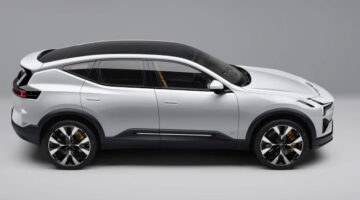One day ahead of its Paris Motor Show debut, Land Rover has unveiled what it calls ‘the world’s most capable and versatile premium compact SUV’, the new Discovery Sport.
[Not a valid template]The Sport – the first of a new line of Discovery models – was unveiled in flamboyant fashion on an 80-metre barge on the Seine, an event headlined by Rosie Huntington-Whitely for reasons that were never fully explained. Before crankandpiston.com had a chance to quiz Ms Huntington-Whitely on the ‘Discovery Range Rover’ (as she put it) or her time battling Transformers three years ago, the Victoria’s Secret model had already gone, leaving the Discovery Sport itself to soak up the limelight.
Key to the Discovery Sport’s ‘versatility’ (a notable adjective for the newboy) is its innovative new cabin, which makes use of tilt and slide functions for the second row seating plus slim-packaging of the vehicle’s electrical systems to optimise cabin space. The extra room means the Discovery Sport can act as both a 5 and a 5+2 seater vehicle, despite measuring considerably less in length compared with its main rivals, including the BMW X3 and the Audi Q5.
Another key innovation is the new integral multi-link rear suspension, constructed using thin-walled hollow aluminium castings that as well as significantly reducing road noise that enters the cabin also reduces the weight of the system. The change in rear suspension (which subsequently takes up less space) leaves room for a spare wheel mounted under the rear overhang. In an effort to keep the ‘Sport’ in Sport Utility Vehicle however, a lightweight aluminium bodyshell incorporates a lightweight but significantly strengthened core into the design for improved vehicle rigidity.
Underneath the more aerodynamically efficient bodywork lies Land Rover’s 2.0-litre four-cylinder Si4 petrol engine, which produces 240hp and 251lb ft of torque, enough for a 7.8-second 0-60mph (0-97kph) sprint time. Said powerplant is mated to the company’s new nine-speed transmission. The drivetrain itself has undergone 1.2m kilometres of development, covering 13 countries across 300k hours of testing.
Amongst the most notable driver assistance systems is Land Rover’s Terrain Response System, which works in close harmony with the MagneRide adaptive damper system (made up of magnetic particles within a viscous damping fluid, similar to that used in the Range Rover Evoque) to automatically stiffen or soften the suspension accordingly to match the conditions of the road. Amongst the most interesting elements of the Discovery Sport’s safety systems though is the pedestrian airbag mounted under the front bumper, which deploys at anywhere between 25-50kph to reduce the risk of pedestrian injury. This is the first time such a system has been implemented on a Land Rover.
The Discovery branch is just one Land Rover’s ‘families’, slotting neatly as it does between Range Rover and the Defender. The arrival of the new Discovery Sport also marks the end of production for the Freelander.



